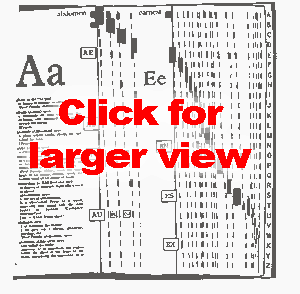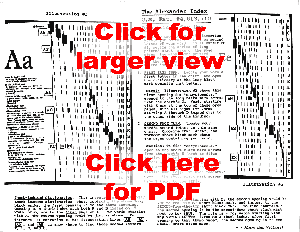|
Written directions how this works. It is better to look at the two videos to see how this works than to read these written directions. Watching a video, a person often thinks "Oh, that looks easy." But reading directions printed in words, sometimes people think this improved dictionary is complicated and hard to learn. These written directions are provided mainly for magazines and other print media, if they decide to include in an article how this works. If a reader of a magazine article only reads an assertion that this invention works, without personally seeing and knowing that this works, the reader would less likely care to make any request that this improved dictionary be brought to the public. It is important for a reader to know how this works. A magazine article could refer to this Website's videos for a reader to know how this works. Or a magazine could include part of what is seen in these written directions to show right in that magazine article how this works.
There are four sets of directions here. A magazine or anyone else could choose among these directions. First, there are two sets of directions, a longer set and a shorter set. Then there is one set of directions, with two illustrations and words all included on one page. Last, there are sample directions that could be included on the inside back cover of a dictionary that does not have thumb indexing– – this last set being provided for anyone to see how simple those directions could be. To start off, to accompany a photograph and one illustration, are two sets of written directions here, a longer set and a shorter set. If some print media rewrites and shortens these directions, that print media may wish to draw from both sets. This article has an enclosure of a photograph of this improved dictionary. The value of looking at this photograph before looking at an illustration of this improved dictionary, is the photograph gives a wide-view perspective of part of this improved dictionary. This wide-view perspective will help you see how the later illustration fits in and is part of a dictionary. To see this photograph, please click on the blue-underlined hyperlink that follows: Click here. The next enclosure is an illustration of this improved dictionary, United States Patent Number 4,813,710. If a person did not first look at the photograph above, a person might not know what to make of this illustration – – where is the back cover on it, where are the page edges?
Longer set of Directions: The larger Illustration shows the page edges of an opened dictionary, from words starting with “A” all the way to the inside back cover at the far right. Notice at the right the vertical alphabet chart A – Z on the inside back cover, plus two sizes of printed marks on the page edges. Those 26 dark/long marks in a diagonal line are to find the first letter of any word, and the many lighter/short marks peppered all over the page edges are to find the second letter of any word. To find the word “album,” first find letter A in the chart, and open to the long printed mark across from A. That is where this illustration is opened to, the first page of A, with that long printed mark at the top of that page. Then find the second letter of album in this same chart. Look across from that L in the chart, to the topmost short mark on those already opened pages. Open there (to the right of pointer box AL) for the second page turn, where you will find words starting A-L. Similarly, to find the word “aorta” or “authentic,” make the second page turn across from the O or the U in the chart. (Little pointer boxes AL, AO, AU and AE were added into this illustration, though those boxes are not part of the invention.) To show some other examples with words starting with E, there is a gap partway into this illustration showing the first page of E, where the first opening would be made to that long printed mark across from the E in the chart. To find the word “enter,” look across from that second letter N in the chart and open to that short mark. To find the word “escort” or “exchange,” look across from the S or X in the chart. The general rule to find any word is (1) Find its first letter in the chart, and open to the long printed mark across from that first letter. (2) Then find the second letter of that word in the same chart, and open to the topmost short printed mark across from that second letter. This invention is also for thumb-indexed dictionaries. The long printed marks would not be needed there. Thumb indexing would start on the first page of a first letter. Where there is one thumb index for both first letters A and B, to find a word starting B-U, open to the second (not topmost) mark across from second letter U. See pointer boxes BU and CU.
Shorter set of Directions: With two page turns in this dictionary, this invention brings you to the first and then second letters of your word. Notice on this opened dictionary at the right the vertical alphabet chart A to Z on the inside back cover – and on all the many page edges the two sizes of printed black marks. Notice the 26 dark/long marks to find the first letter of any word, and the many lighter/short marks peppered all over the page edges to find the second letter of any word. (1) Find the first letter of your word in the chart, and open to the long black mark across from that first letter. (2) Then find the second letter of your word elsewhere in this same chart, and open to the topmost short mark across from that second letter. Though not part of the invention, pointer boxes are shown here, to the left of short marks where you would open for words starting AL (for instance “album”), AU (‘authentic”), AE, AO – and also EN (“energy”), ES, and EX.
________________________________________________________
One-page directions with two illustrations. The next enclosure has a single page with two illustrations on it, with also written directions on that single page. At the bottom of that single page is also described how this Index would be used on a dictionary with thumb indexing.
Directions on the inside back cover of a dictionary. These directions were designed for a dictionary without thumb indexing, specifically a Thorndike-Barnhart Student Dictionary with 1280 pages of definitions. This Index was applied to this dictionary by hand and not by publishing. The second video shows for this same dictionary how to apply this Index by hand. These directions can be put just on the inside back cover, or part of these directions can be included on the adjacent page to the back cover. It helps in these directions to give specific page numbers where a person will be turning. Of course, for a different dictionary without thumb indexing, there would be different page numbers. These directions for the inside back cover of a dictionary are shown in the following: ____________________________________________________
How to Use the Dictionary Index This index helps you find your word very quickly and easily. The steps below are detailed only to be completely unambiguous. After you use this Index to find several words, you won't need further instruction. You use the vertical alphabet (on the inside back cover) twice, locating the page you need as shown in the following examples:
SUMMARY 1. To find your word, locate its first letter in the vertical alphabet and open the dictionary at the long black band opposite that letter. 2. Then locate your word's second letter in the vertical alphabet. Opposite that letter, the topmost short black band marks the pages containing your word.
United States Patent Number 4,813,710
Copyright © 2002
|

